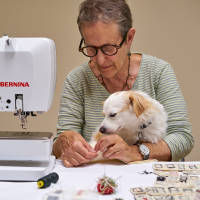
Lisa Kokin lives and works in El Sobrante, California with her spouse, photographer Lia Roozendaal; Austin and Ollie, her canine studio assistants; and Bindi the cat. The daughter of upholsterers, she stitches everything she can get her hands on. Kokin brings a fiber sensibility and a conceptual approach to a diverse array of materials, including fabrics, paper, metal, and shredded money. Her work is often a commentary on the world around her, often incorporating the age-old Jewish response to adversity—humor—and an empathy for the underdog, which she attributes to growing up in a secular, liberal Jewish family in which issues of social justice were often discussed.
Kokin has been the recipient of multiple awards and commissions, including a Eureka Fellowship, a WESTAF/NEA Regional Fellowship, the Dorothy Saxe Invitational Award for Creativity in Contemporary Arts from The Contemporary Jewish Museum, the Alameda County Arts Commission (multiple venues), and the Richmond Civic Center Public Art Interior Acquisitions Project. Her work is in numerous public and private collections, including the Boise Art Museum, the Buchenwald Memorial, the di Rosa Preserve, Mills College, Kaiser Permanente San Francisco, Yale University Art Museum, and Tiffany & Co.
Kokin is represented by Gail Severn Gallery in Ketchum, ID.